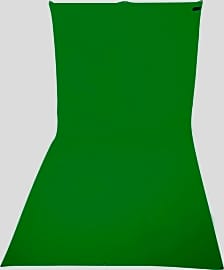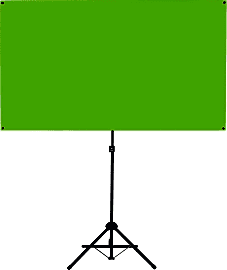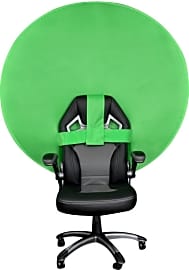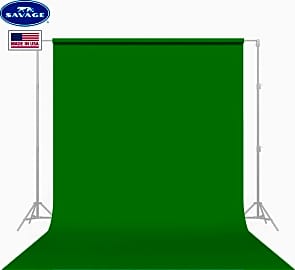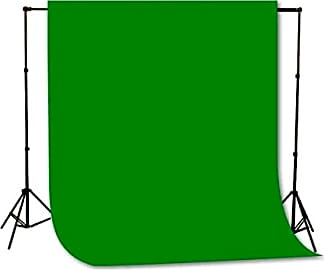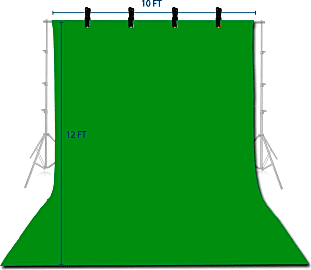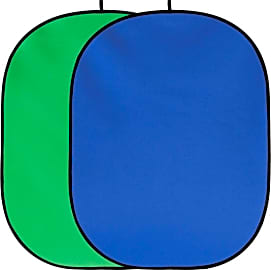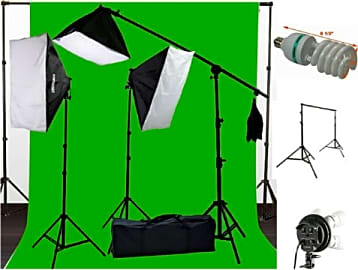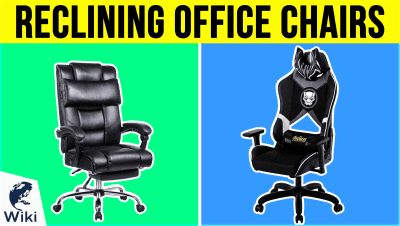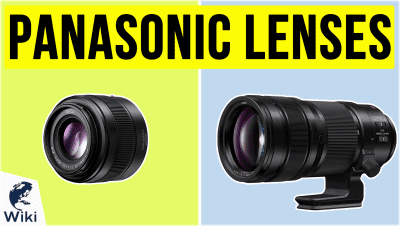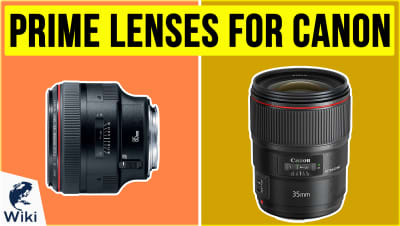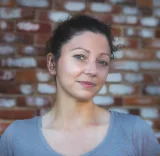The 10 Best Green Screens

This wiki has been updated 37 times since it was first published in December of 2016. You don't need a massive travel budget to produce photographs and videos with backgrounds from anywhere in the world. These green screens allow you to digitally insert anyone or anything in front of whatever scenery, color, or image you like. We’ve included models that work well for streaming gamers, professional YouTube channels, and content creators who want to expand their horizons. When users buy our independently chosen editorial recommendations, we may earn commissions to help fund the Wiki.
Editor's Notes
July 17, 2020:
We've kept both screens that come with stands and those that do not, so there are options for complete newbies as well as those who already have some equipment but need a replacement screen. In the former category, either the Fancierstudio Chromakey Kit or the ePhoto Lighting Kit are good choices; they have the tools to get you started, but it's worth noting that they are not made to professional-quality standards. If you need something simpler that you can set up and tear down quickly, and store with equal ease, the Elgato Collapsible and the Valera Explorer remain top choices. They should fit comfortably in most smaller rooms, and aren't as prone to wrinkling as some.
If you only need a screen, not a stand, we like the Westcott 9 x 20, which replaces the LimoStudio 9 x 13. The Westcott model is a bit more robust in terms of quality, and it is a cinch to hang, whether you use the grommets or the 3-inch pole pocket. We've also added the Savage Seamless Background Paper as a portable choice. Since it is a roll of paper, you can have a fresh backdrop each time you need one, although this does mean more expense in the long run when compared to reusable fabric.
Finally, we kept the Webaround Portable, although it can be tough to strap it to some office chairs. It's a good choice for those who are truly pressed for space, but keep in mind that you'll probably want to sit still for the best results.
June 11, 2019:
If you're going to be filming a full-body and/or moving subject you'll want a full-blown backdrop like the Limo Studio 9 x 13, but an increasingly more common usage for green screens is for YouTube content and live streaming for gamers. The Elgato Collapsible and Valera Explorer are well-suited for this function and come highly recommend for their ease of setup with their own stands, and when mounted their fabric is held so taut that annoying wrinkles are not a problem.
Among other portable choices we decided to replace the Cowboy Studio Reversible with the similar but superior Fancierstudio Reversible because the fabric on the latter has a less shiny, more matte finish than the former, with the added benefit that this fabric doesn't retain as many wrinkles.
Special Honors
Draper VCB Access E For small to medium sized boardrooms that require a high-quality, permanent option for video-conferencing, the Draper VCB Access E is one to consider. A ceiling-recessed, free-hanging model, it is offered in chroma key green as well as a range of other colors, from charcoal to linen. draperinc.com
Pro Cyc Virtual Green With the Pro Cyc Virtual Green, a permanent, non-glossy chroma key surface is just a few coats of paint away. A totally safe, lead-free paint that's manufactured in the USA, it matches Pro Cyc's green flooring, so you can create a high-quality studio in a flash. procyc.com
Manfrotto Lastolite Panoramic The price may put it out of reach of some casual streamers, but for those who are serious about creating content, the Manfrotto Lastolite Panoramic is a large, professional-quality option. The background is conveniently self-supporting, so you won't struggle to hang it, but it folds down into a compact case for travel. manfrotto.com
How Does A Green Screen Work?
The reality is that green screen is all about subtraction before it can be about addition.
If you’ve never used a green screen, you’d be forgiven for finding them a little mysterious. Actors stand in front of a giant piece of bright green fabric, a team of computer wizards hits a few buttons, and the next thing you know those actors are in space, or underwater, or in some fantasy realm that doesn’t exist on our earthly plane.
It’d be easy to imagine that the strange, otherworldly images that end up in movies and TV shows are somehow projected onto the green screen in post, but this doesn’t quite hit the mark. The reality is that green screen is all about subtraction before it can be about addition. When an editor gets footage of an actor in front of a green screen, he or she uses the technology at their fingertips to subtract all the elements of the frame that contain that specific shade of green.
Only after this subtraction takes place can the other backgrounds, characters, and effects be placed in the frame with the actor. It can easily get a lot more complicated than the process as I just described it, but that’s the gist of it. Fortunately for editors, compositors, and other digital post-production professionals, the software used to substitute computer generated backgrounds for the green screen has become more and more advanced as the use of the technology has become more ubiquitous. It takes little more than a few keystrokes and mouse swipes to separate an actor from the background and put whatever you want in its place.
If you want to find out just how easy it is for anybody to swap out that green background for just about anything, take whatever green screen you purchase and tape yourself doing silly things in front of it, post it online, and ask your community to add a background. You’ll be tickled, and a little horrified, at the results. Who knows? You might even go viral.
How To Make A Green Screen Look Good
Just because it’s easier than ever to tape footage in front of a green screen, dump it into editing software, and swap out that background, that doesn’t stop users from finding infinite ways to make that new background look horrible. Fortunately, a few smart techniques and investments can take your green screen work from amateurish to professional in no time.
Changes in light intensity result in changes of perceived color value both to the human eye and to editing software.
The first thing you need to do is light your green screen evenly. Changes in light intensity result in changes of perceived color value both to the human eye and to editing software. Most editing suites have the ability to recognize the industry standard chroma green, as well as shades created in either direction by under and overexposure. If you have too many color values, or too drastic a color shift from a poorly or unevenly lit green screen, however, your editing software might not recognize all of it. That means you’re going to have to go in and splice your actors away from the background through keyframes, which will require an immense amount of time and effort.
This problem has become so universal that there are some apps you can download on smart devices that will use their cameras to measure the light reflecting off your green screen, and these can tell you what adjustments you need to make to maximize its effect. At the end of this process, you might realize that you need a better set of studio lights, ideally something in the daylight spectrum that has a high CRI value, which helps ensure accurate color reproduction in-camera.
Once your green screen is well lit, you might run into another issue: green reflections on your actors. Light is inevitably going to bounce off your green screen, and if it splashes on your actors, it can cause the background replacement to creep into their clothes or their skin. Even if it doesn’t effect the background replacement, it can throw off your color grading or at least cause the audience to wonder why there’s a strange green reflection in your actors’ eyes.
Once you’re in post with a well-shot bit of green screen, make sure you know what lenses each setup used, as well as what T-stop the lens was set to. If you were using a shallow depth of field on set, and your actors’ faces are sharp, then the background has to be appropriately out of focus. If the background file you’re using is too sharp, there are defocusing effects you can apply to it to make it seem more realistic.
A Brief History Of Green Screen
Before the advent of green screen and blue screen, the most common technique used to replace the background behind actors was called rear projection. Essentially, you could set up a projector behind a white screen hung behind your actors, and whatever you projected onto the screen would appear behind your actors. This was most often used for driving scenes to make it seem like the car and its passengers were traveling from one place to the next, when in fact they were sitting stationary in a studio with a production assistant bouncing gently on the bumper to simulate movement.
Blue screen came next, and is actually older than you might think, getting its start in the 1930s. It’s important to remember that most films produced in the first 20 years of blue screen were black and white, and that this particular bold shade of blue didn’t occur in much clothing. Years later, as similar blue colors crept into our daily fashions, actors and wardrobe designers had to avoid them, lest their tie suddenly match the background of the shot.
The answer to this problem was green screen, an industry standard called chroma key or chroma green that came into being as digital cinematography supplanted celluloid film in both film and television. Blue screen is still occasionally used, but thanks to its universality and its rarity among wardrobe items, it seems that chroma green is here to stay.


